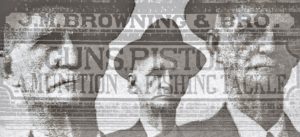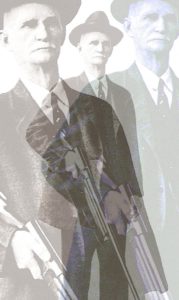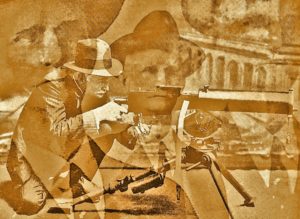
A Man of Invention
By: Robert Dunn
When someone describes a person as being inventive, creative, prolific and a genius, certain historic men come to mind. Michelangelo, da Vinci, Newton, Mozart, Escher, Edison are all names of people that have the above qualities. Many of you will have already thought of these historic men based upon these attributes. I must add another man’s name to this list, John Moses Browning. Some folks that have never shot a gun or live in a cave may not know this name, but if you had just said Browning, even the uninitiated would recognize the name as much as Winchester, Colt, or Smith and Wesson. John Browning was not just an inventor or Gunsmith; he was an innovator and a genius. Like Beethoven, who could listen to completed symphonies in his head and then when needed put the notes to paper to be played by the orchestra, John Browning could see the designs of multiple working parts and their function in his mind and fashion sketches from which working models could be made to share his ideas and firearms with the world. John M. Browning was born in 1855 and died in 1926. During these prolific years of John’s life, he managed to take out over 100 patents, invent several of the world’s most popular firearms, raise a family and literally save nations with his designs. It’s natural for boys to try and follow in their father’s footsteps and many will surpass their elders and mentors as they gain their own skill, knowledge and style. John’s father, Jonathan, was also a Gunsmith and an inventor. In keeping with this tradition, Jonathan’s son would end up changing the firearms industry more than anyone in history. During Jonathan’s time, flintlocks and matchlocks were the guns that were in use and he cut his teeth repairing and building these types of guns. He painstakingly sought out his Gunsmithing knowledge and ended up inventing a couple of innovative repeating rifles. John Browning’s most famous guns may be the Model 1911 pistol, the Automatic Five shotgun or even some of his machine gun designs. Many people do not know that the humble gunsmith practically carried the entire Winchester Company with his firearms patents and designs throughout the late 1800s. Winchester bought John’s rock solid single shot rifle, the Model 1885, and the company went on to buy dozens of his firearms, even if it was just to keep their competitors from John’s inventions.
John M. Browning was born and raised in Ogden, Utah. He grew up with his brother Matt, whom he would continue to be close to for his entire life. When John was a boy, his toys were the tools with which his father repaired and built his firearms. A large used gun parts pile had accumulated in his father’s shop over the years and it was John’s pile of playthings while growing up. Having a knack for gun work and intuitive thinking, John made his first firearm at the age of ten. He went to school primarily to learn to write repair tags.
In 1878, John, at only twenty-three years of age, invented his first gun. This firearm was to become the Winchester Model 1885. During this same year, he invented another single shot rifle. This would begin a non-ending prolific wave of invention. John Browning and his brothers had built The Browning Brothers Factory by 1880. Within the first few months, they met their goal of producing their first 25 Single Shot Rifles, which sold quickly! John was married by this time and had taken on a lot of responsibility. He had employees to pay and mouths to feed. With the Transcontinental Railroad connecting Ogden to Salt Lake City, business and commerce began to accelerate. John’s inventive streak continued with two repeating rifle designs. Around this same time period, a salesman from the Winchester Company bought one of the Browning single shot rifles and sent it to the Winchester factory for evaluation. The Vice President/General manager of The Winchester Repeating Arms Company, T.G. Bennett, personally came to Utah to specifically buy the rifle from John. With not much more than a handshake, this began a relationship between The Brownings and Winchester that would last almost two decades. Within this time frame, John sold to Winchester 44 different guns, 10 of which were manufactured. Such firearms as the .22 caliber Model 90 pump gun, the Model 1894 (the .30-30 chambering was very popular with hunters) and the Model 97 pump shotgun (which was used in WWI). These were all reliable and rugged firearms. John’s relationship with Winchester ended over royalty disputes with regard to the Automatic Five Shotgun. John was restless and wanted to see this firearm go into production. Fabrique Nationale in Belgium was already manufacturing a handgun of John’s design, so they were awarded the contract. Remington and Savage would later produce the Auto Five, calling them the Model 11 and Model 720, respectively. By this time John was experimenting with gas operation and had already patented two designs. A letter from Matt Browning to Colt telling them about Browning’s new machine gun designs sparked Colt’s interest. The two Browning brothers demonstrated their machine gun for Colt with great success. This event would do wonders in their ability to network with the Military. The Navy ended up ordering 50 Colt Model 1895 Automatic Machine Guns. Variations in both water and air-cooled machine guns followed. Around the turn of the century, both Colt and Fabrique Nationale were making John Browning’s guns. Millions of rifles of his design had been sold and other inventions of his were used in many of the firearms factories that he visited. The Browning Automatic Rifle (B.A.R.) and the Colt 1911 pistol were both adopted by the military. The Model 1917 .30 caliber water-cooled machine gun was also put to use by our armed forces. John Browning saved our country millions of dollars during the monetary negotiations for his many designs and inventions that were put to use during World War I. John simply and patriotically accepted the terms the government first offered. John would then devote two years of his life overseeing production in six different factories. Working with such names as Colt, Remington, Marlin, Westinghouse, and Winchester kept John busy, but he was still inventing. More rifle, pistol and machine gun designs would continue to flow from John’s creative mind. He even invented a 37-mm. cannon for the military. His .50 caliber machine guns are still striking fear in our enemies to this day. His designs have been employed on land, air, and sea bearing crafts.